Design Criteria for Rebars
|
|
|
|
|
|
Enter the standard sizes of main and sub-rebars used in the design of beam, column and brace members. Also, enter the standard sizes and spacing for vertical and horizontal rebars used in the design of shear wall members. |
|
|
|
|
|
|
|
From the Main Menu select Design > Concrete Design Parameter > Design Criteria for Rebars.
From the Menu tab of the Tree Menu select Design > Concrete Design Parameter > Design Criteria for Rebars. |
|
|
|
|
|
The following dialog box is used to enter the data:
Design Criteria of Rebar dialog box
[Taiwan Only]
Design Criteria for Rebars dialog box (Taiwan)
For Beam Design (refer to Note 1)
Enter the standard sizes of main and sub-rebars and the placement locations of the main rebars used in the design of beam members.
Main Rebar: Main rebar standard sizes for the design of beam members
Click to display the Rebar Size dialog box. Select with the mouse to enter the main rebar standard sizes. A maximum of 5 main rebar standard sizes can be entered. ASTM and KS Standards may be used together.
Rebar Size dialog box
Stirrup Bar: Standard sizes for transverse reinforcing bars in beam design
Side Bar: Standard sizes for side bars, used for bar placing. Beam strength is not affected
Arrangement: Number of shear reinforcement legs
Note 1. Under the IS456:2000 Concrete Design Code, only an even number can be selected in the Arrangement field. 2. Limitations: a. When an odd number is entered in the Arrangement field and the specified concrete design code is changed to IS456:2000, design is not performed for the corresponding members. b. When an odd number is entered in the Arrangement field and the user opens the Design Criteria for Rebar dialog after changing the concrete design code to IS456:2000, a value of 2 is automatically entered in the Arrangement field.
dT: Distance between the center of the main rebars in the top layer of the top bars and the top surface of the section (cover thickness)
dB: Distance between the center of the main rebars in the lower layer of the bottom bars and the bottom surface of the section (cover thickness)
Note When calculating the maximum number of rebars that can be placed within 1 layer, the side cover of the beam shall be taken as the lesser of dT and dB specified in "Design Criteria for Rebars".
Doubly Rebar (Taiwan only): Option to use Doubly Reinforced Beam Design. In the beam design, the program can consider both tension and compression reinforcement. Compression reinforcement is considered in calculating moment capacity when the applied design moment exceeds the maximum moment capacity of a singly reinforced section. In other words, compression reinforcement is considered when the required tensile rebars exceed the maximum tensile rebar limit.
k*0.75*Rohb, k : Maximum tensile rebar limit can be specified by entering the ratio (k) as a scale factor of the reinforcement limit (0.75¥ñb).
Note User Input of compressive
rebar ratio
Note
2. When “Special Provisions for Seismic Design” and “Doubly Reinforced Beam Design” are simultaneously applied, the larger of the compressive rebar ratio as per “Special Provisions for Seismic Design” and the compressive rebar ratio as per “Doubly Reinforced Beam Design” is applied.
Consider Spacing Limit for Main Rebar : Check on to apply the requirement of rebar spacing as per the design code. If this option is checked off, the program does not consider rebar spacing in performing automatic design. Spliced bar : Select a splicing option for the main rebars in the automatic design. The default automatic design selects None. =None: Number of main rebars calculated without considering splicing =50%: Number of main rebars calculated considering 50%-splicing =100%: Number of main rebars calculated considering 50%-splicing
For Column Design (refer to Note 2)
Enter the standard sizes of main and sub-rebars for column members.
Main Rebar: Main rebar standard sizes for the design of column members (The entry is similar to that for "Main Rebar" of "For Beam Design".)
Tie/Spiral Bar: Standard sizes for tie bars used in column design
Arrangement: Number of shear reinforcement legs
Note
do: Cover distance from the center of main rebars Consider Spacing Limit for Main Rebar : Check on to apply the requirement of rebar spacing as per the design code. If this option is checked off, the program does not consider rebar spacing in performing automatic design. Note The program did not provide required rebar areas for the column design, which sometimes caused inconvenience when the user tried to manipulate reinforcement. For this, checking off “Consider Spacing Limit for Main Rebar” option allows the user to find the required rebar area beyond the code required spacing. Spliced bar : Select a splicing option for the main rebars in the automatic design. The default automatic design selects None. =None: Number of main rebars calculated without considering splicing =50%: Number of main rebars calculated considering 50%-splicing =100%: Number of main rebars calculated considering 50%-splicing
For Brace Design (refer to Note 3)
Enter the main and shear rebar sizes for diagonal members.
Main Rebar: Main rebar size for diagonal members (data entry is identical to that for "Main Rebar" input method in "For Beam Design".)
Tie/Spiral Bar: Shear rebar size for diagonal members
Arrangement: Number of shear reinforcement legs
Note
do: Cover distance from the center of main rebars Consider Spacing Limit for Main Rebar : Check on to apply the requirement of rebar spacing as per the design code. If this option is checked off, the program does not consider rebar spacing in performing automatic design. Note The program did not provide required rebar areas for the column design, which sometimes caused inconvenience when the user tried to manipulate reinforcement. For this, checking off “Consider Spacing Limit for Main Rebar” option allows the user to find the required rebar area beyond the code required spacing. Spliced bar : Select a splicing option for the main rebars in the automatic design. The default automatic design selects None. =None: Number of main rebars calculated without considering splicing =50%: Number of main rebars calculated considering 50%-splicing =100%: Number of main rebars calculated considering 50%-splicing
For Shear Wall Design (refer to Note 4)
Enter the standard sizes of vertical and horizontal rebars and the placement layout of vertical rebars for shear wall members.
Vertical Rebar: Standard sizes for vertical rebars used in shear wall design
Horizontal Rebar: Standard size for horizontal rebars used in shear wall design
Boundary Element Rebar: Standard sizes for Rebar used in Boundary Element .
Boundary Element Rebar Space: Enter spacing of Rebar for Rebar entered in Boundary Element Rebar.
End Rebar From: The minimum standard size to be used for end rebars for shear wall design.
de: Distance from the end of the shear wall member to the center of the first row of the vertical rebars (or end rebars) (cover thickness)
dw: Distance between the center of the end vertical rebars and the end of the shear wall (cover thickness)
Click to display the dialog box shown. Enter additional wall data such as rebar spacing and rebar standard sizes used for the shear wall members, and select end rebar design method, out-of-plane strength design, etc.
Input Additional Wall Data dialog box
Design of Out-of-plane Bending
Determine whether to design the wall for a bending moment about the weak axis.
Spacing of Wall Rebars
Enter the spacings of the vertical and horizontal rebars for every shear wall member.
Spacing of Vertical Rebars: refer to Note 4
Click
Spacing dialog box
List for Selection
List for Design Select and list the rebar spacings to be applied. A maximum of 50 spacings can be selected.
User Input Spacing
Click
Spacing of Horizontal Rebars:
refer to Note 4
End Rebar Design Method
Select the method of designing shear walls considering end rebars.
Not Used
Method-1: Place the rebars at equal intervals over the entire wall length (no end rebars)
Auto Calculation
Method-2: Assuming that the wall is reinforced uniformly at an equal spacing over the entire length of the wall, determine additionally required rebars, then place the rebars at the ends and the center part.
Method-3: Assuming that the vertical rebars at both ends of the wall resist all the axial force (Pu) and the bending moment (Mu), determine the required reinforcing steel for the shear force resisted by the remaining part.
Method-4: Identical to Method-2 and end rebars placed from 2EA
Spacing of End Rebars
Enter the spacing of end rebars used in the shear wall design.
Dist1: Spacing of end rebars in the case of 4 end rebars
Dist2: Spacing of end rebars in the case of 6 end rebars
Dist3: Spacing of end rebars in the case of 8 end rebars
Note
1
Main
Rebars: #9
If dT and dB are not entered (ie. 0), the program uses the larger of 2.5"(63.5mm) and H/10, but not exceeding 3 inches.
Note
2
Main
Rebars: #9
If d0 is not entered (ie. 0), the program uses the larger of 2.5"(63.5mm) and H/10, but not exceeding 3 inches.
Note
3
Note
4
Vertical
Rebars : #5
The standard rebar sizes or rebar spacings for design can be selectively limited to satisfy the design purpose. If the values dw and de are not entered (in case where they are 0), 2 inches (5.08cm) are automatically used.
|
|
|
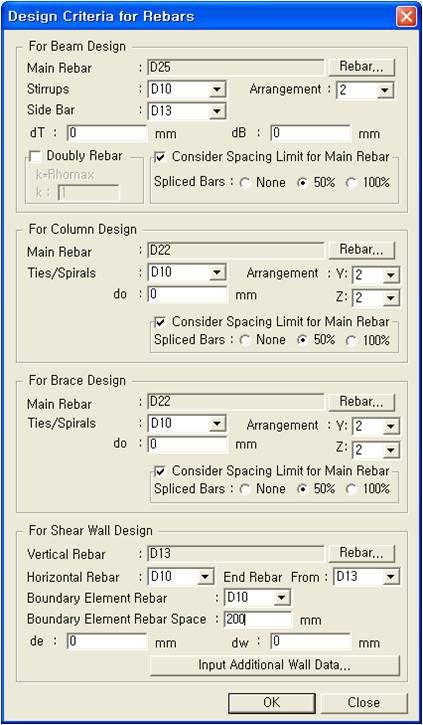
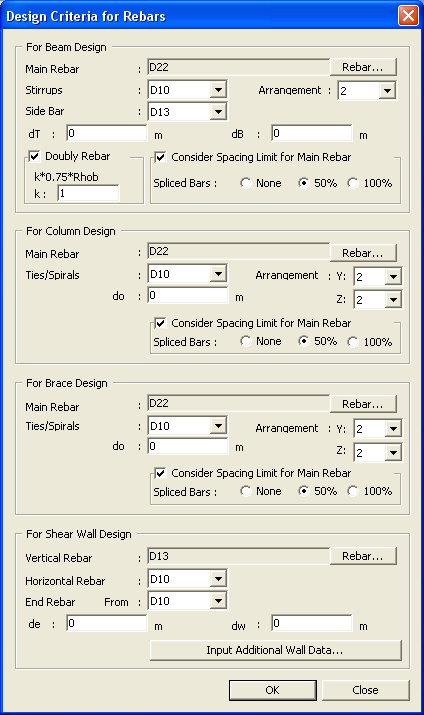
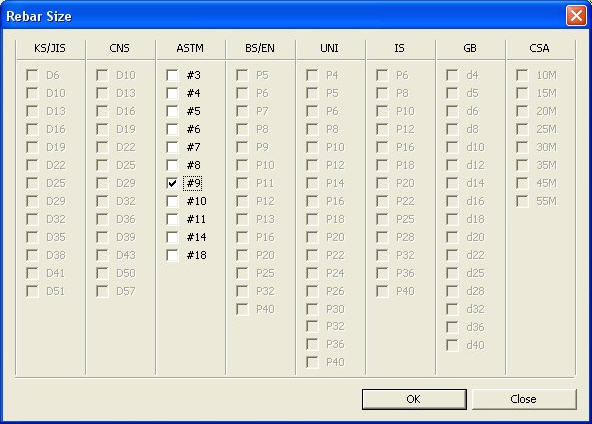
 : Apply the selection
and close the dialog box.
: Apply the selection
and close the dialog box. : Do not apply the selection
and close the dialog box.
: Do not apply the selection
and close the dialog box. Revision of Ver.7.5.0
Revision of Ver.7.5.0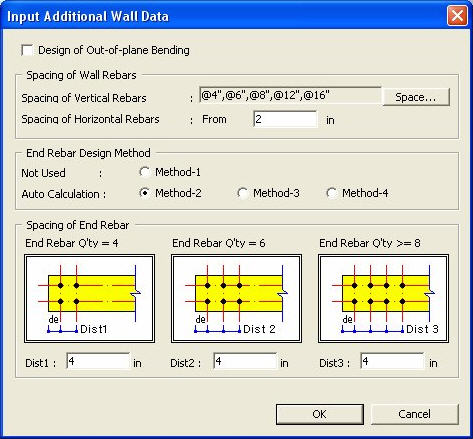
 to display the Spacing
dialog box and, with the mouse, enter the spacings for the vertical rebars
in the shear wall member. Use "mm" or "in" for the
spacing unit.
to display the Spacing
dialog box and, with the mouse, enter the spacings for the vertical rebars
in the shear wall member. Use "mm" or "in" for the
spacing unit.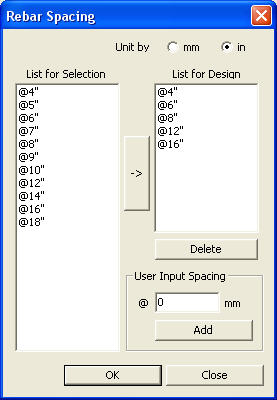
 : Delete selected spacings
from the list.
: Delete selected spacings
from the list. to add a new spacing
to the List for Selection after entering a new spacing.
to add a new spacing
to the List for Selection after entering a new spacing.  : Cancel the current
operation.
: Cancel the current
operation.